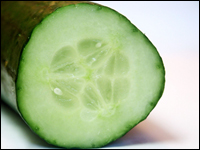Dear Umbra,
I recently learned that the UPC numbers on produce indicate whether the item is conventionally grown (beginning with a 4), organically grown (beginning with a 9), or genetically modified (beginning with an 8). I like to buy organic, locally grown produce at my local health food store whenever possible, but recently at a large grocery story I noticed some tomatoes with a UPC number that began with a 3. What does a 3 indicate?
Robin
Louisville, Ky.
Dearest Robin,

Sounds like you are thinking of the PLU code, the four or five digits on the super-sticky little sticker stuck on produce — not the UPC code, which is the string of 12 digits under and related to the bar code. The UPC (or Universal Product Code) numbers are used with food items such as cans of soup, which come in identical units. While we are accustomed to paying $1.97 for every can of soup, we would find it odd to pay $1.97 for all cucumbers regardless of size.
Hence the PLU code, which enables cashiers to easily determine the price of “variable weight” items. PLU codes can begin with either a 3 or a 4 and are four digits long — unless the produce is organic, in which case the PLU is five digits long and begins with a 9. If the sticker on your conventional cuke says #4062, its organic brethren are #94062. The cashier types in the PLU while the cuke is on the register scale, and the computer uses that number to look up the cuke’s price per pound. (Hence “PLU” for “Product Look Up” code.) The exact cost is then calculated before your eyes.

Organic produce has a different cost, so checkers need to differentiate the organic cuke from the conventional one. Since organic produce is labeled and advertised as such, though, you shouldn’t need to be decoding stickers to know what you’re buying.
About the number 8: It was instituted back when the produce industry thought consumers would like and pay more for genetically modified food than conventional food. (A hypothetical GM cuke would be #84062.) Now, of course, they know better, but the 8 is still out there. I’ve never seen it, so please send along an example if you find one. There isn’t much genetically modified produce available; rumor has it that papayas are the only GM hand fruit. (That’s fruit you can pick up and eat in your hand — a little ag jargon for you.)
Unfortunately, other genetically modified food is not labeled. At all. But the perspicacious shopper can dodge the mysterious effects of GM food by reading labels. Corn, soy, and cottonseed oil are largely genetically rigged in the U.S., so any processed product containing them is probably genetically modified. On the other hand, organic food is GM-free, so that’s always a safe way to go. Visit the True Food Network website for further clues.
Weightily,
Umbra


